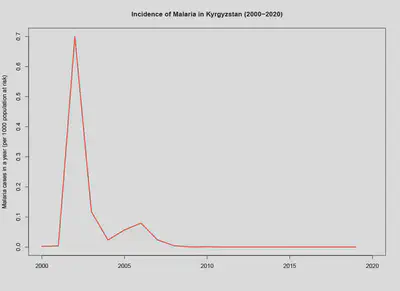2016

Overview
Kyrgyzstan was WHO certified malaria-free in 2016 with the last indigenous case being reported in 2010. Originally certified malaria-free in 1961, Kyrgyzstan had reintroduction of local malaria transmission in 1986 with imported cases coming from Afghanistan. Also, with Kyrgyzstan’s independence from the Soviet Union in the 1990s, there was the introduction of border malaria with free movement of citizens and visitors from malaria-endemic countries. In 2002, Kyrgyzstan experienced a major malaria epidemic with more than 2700 cases of P. vivax malaria following the mass influx of Kyrgyz laborers returning from malaria-endemic countries. Kyrgyzstan’s Ministry of Health received assistance from multiple organizations like the WHO, the U.S. Agency for International Development, and the Medical Emergency Relief International. This allowed them to expand vector control measures, such as the use of larvicides in rice fields and indoor residual spraying. The national surveillance system for malaria detection and investigation was also strengthened, antimalarial drugs were distributed, and community engagement for malaria prevention heightened. Malaria elimination was achieved in Kyrgyzstan through continued malaria control and prevention efforts and improved intersectoral and cross-border collaboration.
Malaria Incidence in Kyrgyzstan (2000-2020)
| Year | Incidence of malaria (per 1,000 population at risk) |
|---|---|
| 2000 | 0.001824 |
| 2001 | 0.003875 |
| 2002 | 0.699911 |
| 2003 | 0.117886 |
| 2004 | 0.023153 |
| 2005 | 0.056836 |
| 2006 | 0.079559 |
| 2007 | 0.023740 |
| 2008 | 0.004391 |
| 2009 | 0.000240 |
| 2010 | 0.000709 |
| 2011 | 0 |
| 2012 | 0 |
| 2013 | 0 |
| 2014 | 0 |
| 2015 | 0 |
| 2016 | 0 |
| 2017 | 0 |
| 2018 | 0 |
| 2019 | 0 |
| 2020 | Data unavailable |
References
Usenbaev, N. T. (2016). ACHIEVING MALARIA ELIMINATION IN THE KYRGYZ REPUBLIC. Meditsinskaia Parazitologiia i Parazitarnye Bolezni, 4(4), 36-39.
World Health Organization. (October 7, 2016). Kyrgyzstan receives WHO certification of malaria elimination. Wkly Epidemol Rec.